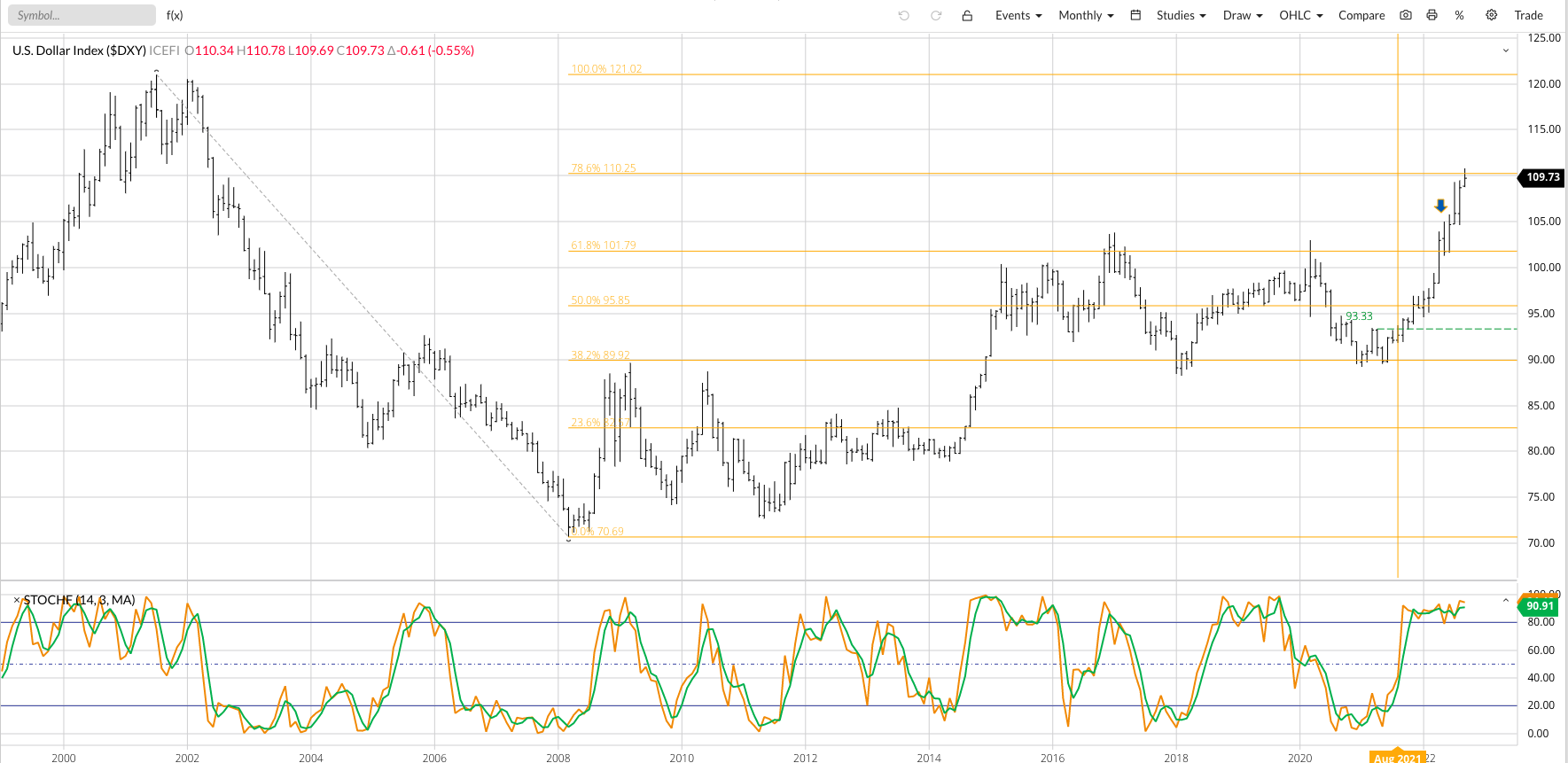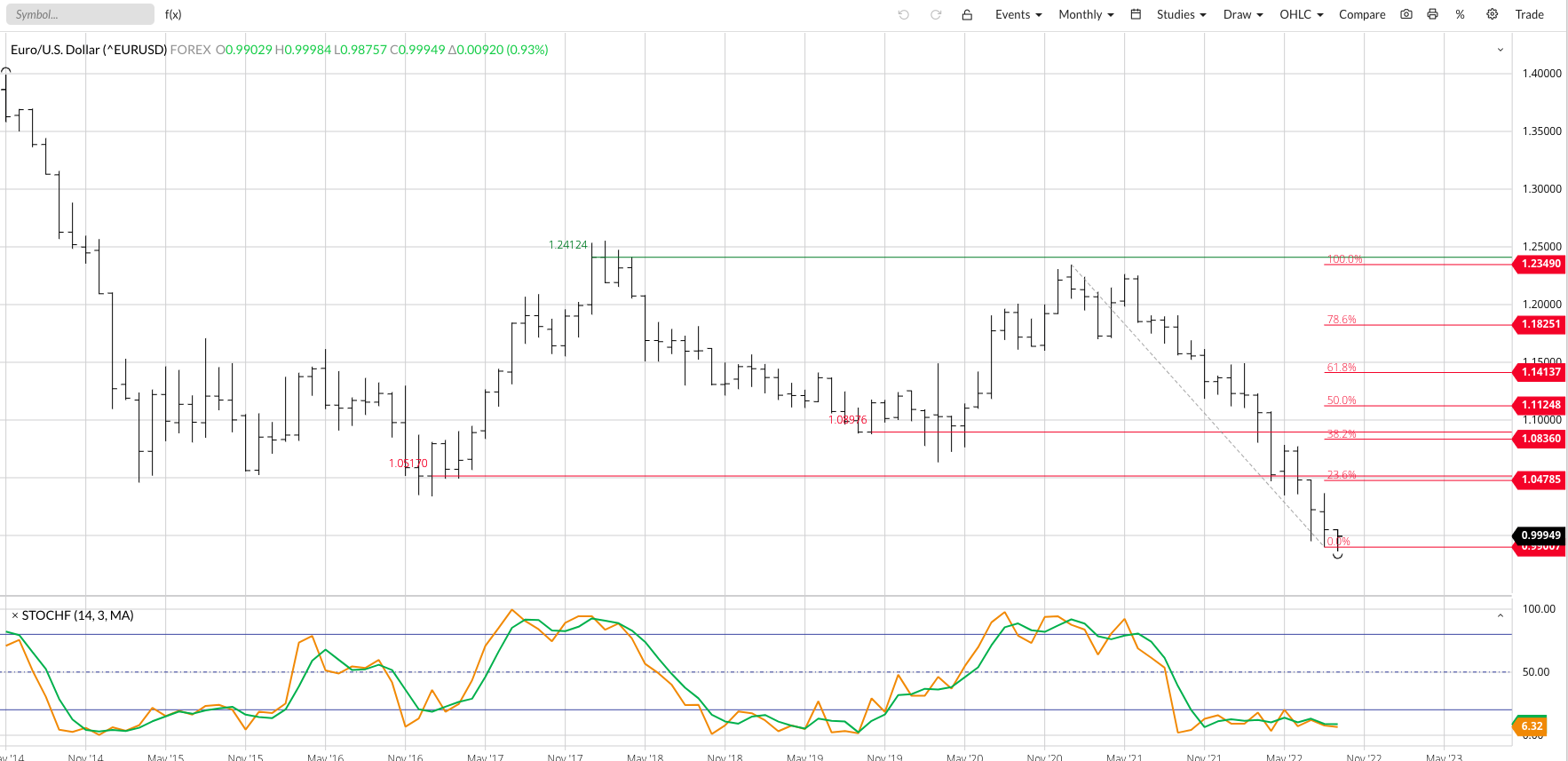
- The US dollar index again extended its long-term uptrend, climbing ever closer to the June 2002 high of 112.04.
- Support continues to come from global investment traders on the idea the US economy is stronger than most anywhere else, with the latest example being a reduction in the trade deficit.
- Unfortunately, global central banks have not accounted for the effects of the Three Mothers in their textbook attempts at corralling inflation with interest rate hikes.
After my discussion last week, the US dollar index was in the spotlight again Wednesday as It extended the long-term uptrend on its monthly chart to a high of 110.79. We’ve talked in the past about how the greenback is at its strongest level since June 2002, with the high that month up at 112.04. The difference between today’s mark and what was going on 20 years ago is that this time around the US dollar index is showing no signs of slowing, despite monthly stochastics sitting deep in overbought territory with fast stochastics holding above 90%. I’ve long used the 80% level as indicating an overbought situation while a drop below 20% signaled an oversold market.

If we apply Newsom’s Market Rule #1[i] to the US dollar index we know much of the support continues to come from global investment traders. Why the rush to buy George Washington’s? After all, the greenback is again at its highest level in more than 20 years and central banks around the world are doing the same thing as the US Federal Reserve: Raising interest rates in a futile attempt to curb inflation. If the playing field for global currencies is relatively flat (bringing to mind Thomas L. Friedman’s tome, “The World is Flat”), then what makes the dollar so special to investors?
One way to describe it is the US dollar may be the best-looking mutt at an ugly dog show. It’s entirely possible global investors see the US economy as stronger than its global counterparts, a notion that roughly 49% of the US vehemently disagree with. But investors tend to not worry about hurt feelings when a solid return on investment is on the line, and for now the US dollar continues to bring the best return. This could, and most likely will, change in the not-too-distant future. The euro is below part with the dollar, hitting a low 0.98658 Tuesday.

Let’s back up a moment to my comment about interest rate hikes being a “futile attempt to curb inflation”. We know it is a textbook reaction by economists, something taught in business schools around the world, but it only considers the truth that inflation is a normal part of the economic cycle. The other truth is ignored, not all inflationary periods are the same. This time around global inflation is being driven by the coming together of Three Mothers, with two of them being Mother Nature and Mother Russia.
Global grain and oilseed supplies, as well as nearly every other commodity (e.g. coffee, cotton, etc.), have been reduced by weather. And with La Nina forecast to hang around South America for a third consecutive year, after the US has seen its production trimmed by adverse weather and China remains in a drought, global grain supplies aren’t expected to grow much in the face of continued strong demand.
Then we have the Madman Across the Water, also known as Vladamir Putin and his illegal invasion of his neighbor and sovereign country Ukraine. This not only disrupted the global grain supply and demand table but also shattered the global energy complex into a thousand pieces. No amount of government intervention, from interest rate hikes to imaginary price caps, is going to take energy supply and demand back to where it was prior to February 2022. We have to move forward with a changed gameplan, one that has included an increase in US exports to the point the current US administration has “asked” domestic oil refiners to “not further increase exports of fuels…” It’s not a huge surprise the US trimmed its trade deficit during July to “only” $70.6 billion, an improvement of $10.3 billion from the previous reading.
[i] Newsom’s Market Rule #1 reminds us to not get crossways with the trend as this reflects the flow of noncommercial or investment money in a market. It goes along with Newton’s First Rule of Motion applied to markets: A trending market will stay in that trend until acted upon by an outside force, with that outside force usually noncommercial/investment activity.
More Forex News from Barchart


/Intel%20Corp_%20Santa%20Clara%20campus-by%20jejim%20via%20Shutterstock.jpg)
/EV%20in%20showroom%20by%20Robert%20Way%20via%20Shutterstock.jpg)
/AI%20(artificial%20intelligence)/Businessman%20touching%20the%20brain%20working%20of%20Artificial%20Intelligence%20(AI)%20Automation%20by%20Suttiphong%20Chandaeng%20via%20Shutterstock.jpg)

